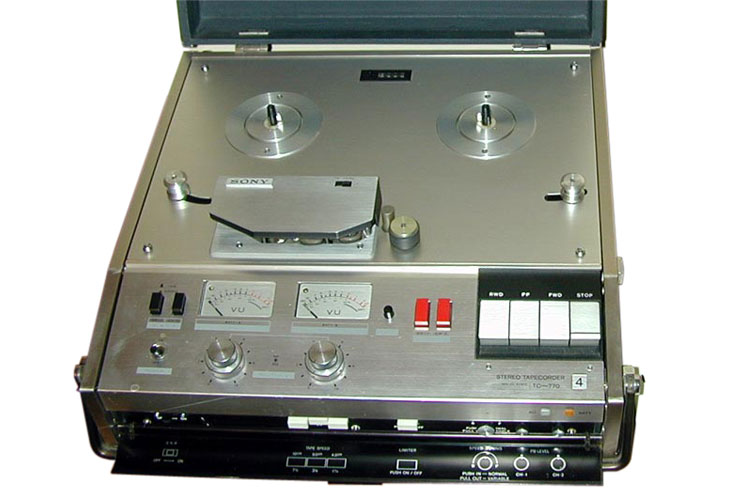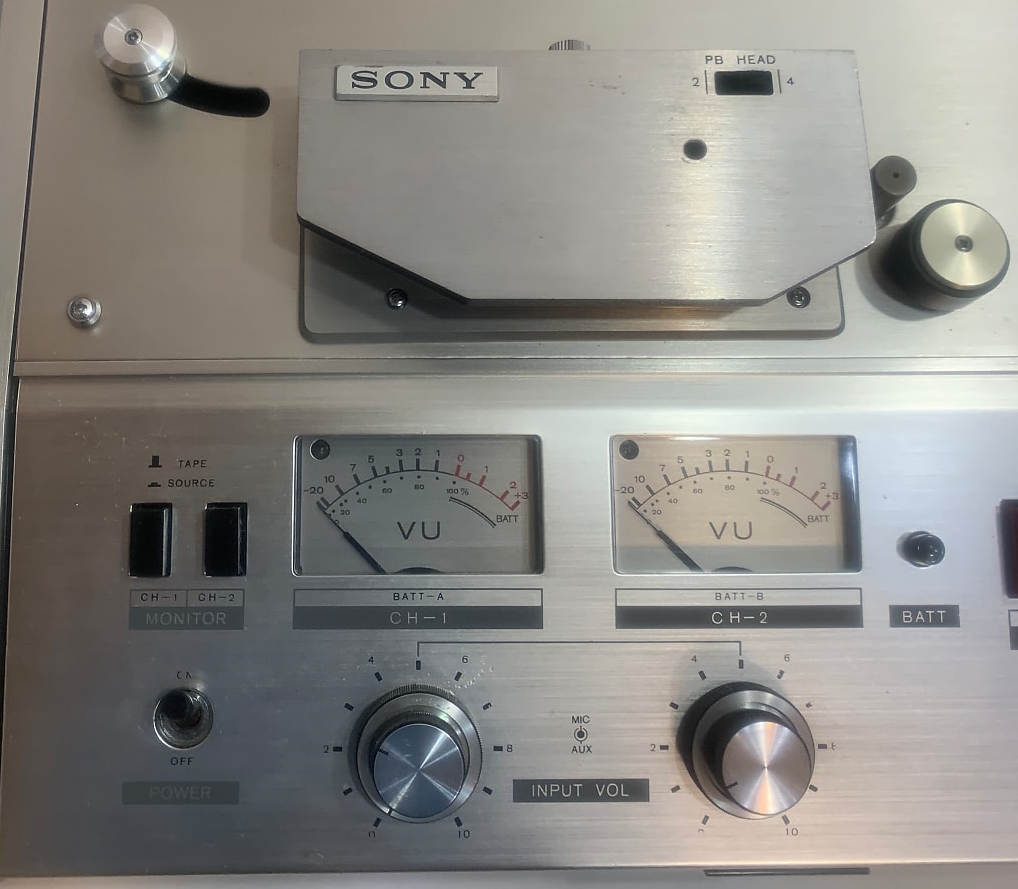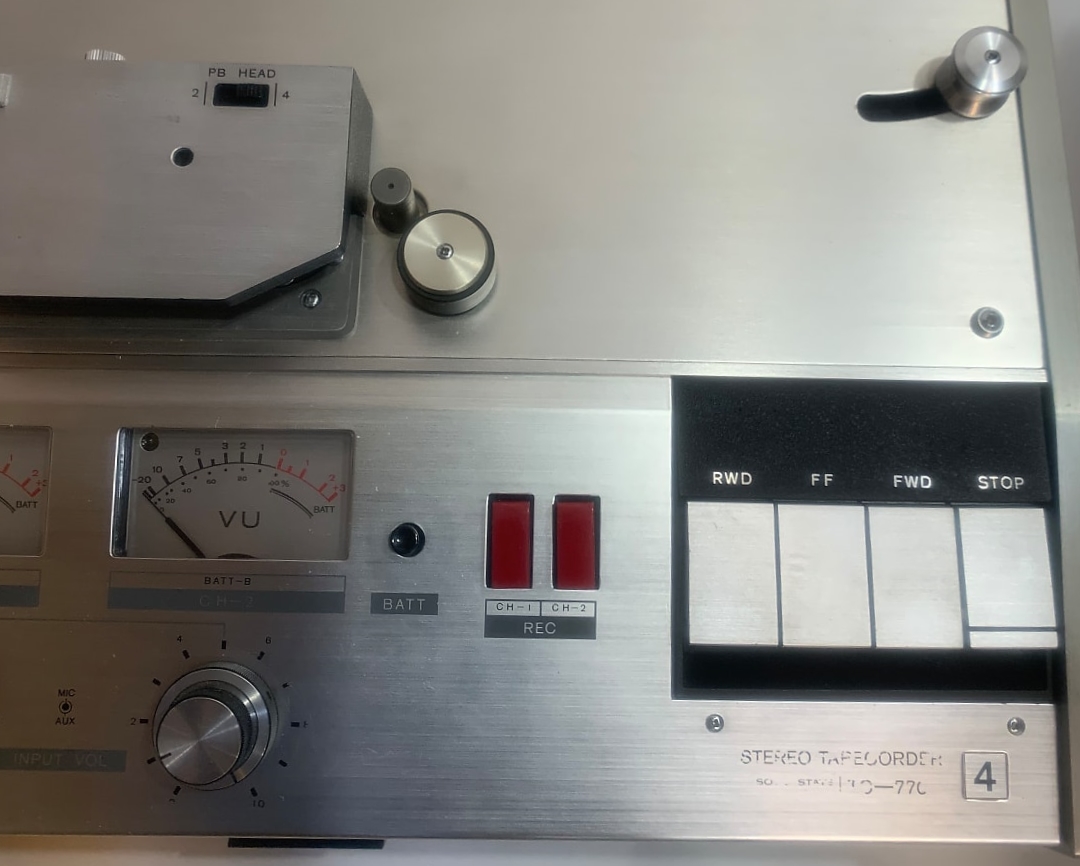Technical Details
Brand: Sony
Model:TC-770
Category:Mid High Fidelity
Application:Portable
Electronics:Solid State
Equalization:NAB
Country of Manufacture:Japan
Release dates:1969 - 1973
Original Price: $750
Tracks:1/4 Rec/PB+1/2PB
Speeds: 1 7/8, 3 3/4, 7 1/2
Max Reel Size("): 7"
Number of heads: 4
Dimension: 16¼ x 5¾ x 15¼" (409 x 148 x 389mm)
Head Composition: Permalloy
Head Configuration: Stereo
# Motors: 1
Auto Reverse?:No
Voltage(s): 110-120v, Multi
Outputs: RCA
Frequency Response:7½ ips: 20Hz -22kHz 3¾ ips: 40Hz -15kHz (3dB)
Wow and Flutter:.09% at 7½ ips, 0.12% at 3¾ ips and 0.20% at 1 ips
Signal-to-Noise Ratio:56 db (quarter-track), 58 db (half-track)
Sound quality rating:7 / 10
Long-term reliability rating: 7/ 10
Weight: 24 lbs (11.2 kg)
Additional Details
Description
This was an unusual recorder. With its sleek design (less than six inches high), internal battery operation, 7-inch reel capacity and excellent specifications for such a small machine, this model found a good home with those needing something for semi-professional field applications. The nickel-cadmium battery pack allowed for about four hours of continuous recording per charge.
XLR microphone connectors were used, as were high quality VU meters, built-in noise reduction and on-board record limiter. Variable speed tuning and a four-head design also were featured.
The interior of the 770 was also unusual. A very simple transport was employed with mechanical servo controls for both supply and take-up reels and an electronic DC servo system for the motor.
Designed expressly for hobbyists and professionals, the TC-770 was a deck only, with no internal amplifiers or speakers supplied.
Two models were available, the 770-4 and 770-2 (quarter and half-track record). In addition, each model had an addition playback head so that they could both play pack half or quarter-track.
Features:
- Four heads for two or four track stereo record/playback
- Servo control motor with built-in Variospeed tuning
- Built-in limiter (with defeat switch)
- Sony SNR noise-reduction system
- Built-in rechargeable lifetime nickel-cadmium battery pack
- Built-in mike & line mixing
- Balanced low impedance Canon XLR microphone inputs
- Two full-sized VU meters calibrated to NAB standards
- Three speeds
See below for a detailed 1969 test report.
Test Report (Audio magazine,May 1969)
Portable, battery-powered tape recorders are a breed in themselves. They have to be light enough to carry comfortably – they must operate on batteries – they must be flexible – and if they are to be used for professional purposes, they must be of the highest quality. Concerning the latter, it is desirable that they have speeds of 7½ ips for their professional applications, and some lower speeds for those applications where they will be required to record for longer periods of time. It is also desirable that they accommodate 7-in. reels with the cover on, and their operating characteristics must be comparable to studio-type machines. All these attributes are offered in the Sony TC-770, the only sacrifice being in the weight department. The model tested was the TC-770-2, which records and plays two tracks, and by throwing a switch, additionally plays four-track tapes. The TC-77-4 records and plays four-track tapes, and the switch permits playing two-track tapes.
The unit is a handsome device, with its pebble-grained black covering and chrome hardware. The inside reveals a chrome metal plate, with reel hubs, which accommodate 7-in. reels, two tension rollers, and the capstan and idler. The head cover is a casting which slips over two slotted pins for location, and locks in place with a thumbscrew at its rear. On the sloping front panel are — from left to right — two monitor push/push buttons to select source or tape monitoring. Below these is the power switch, and the inside of the case is fitted with a plastic projection which prevents the top being put on unless the switch is in the OFF position. To the right are the two VU meters, with the record-level controls below them. These are dual concentric knobs, with the smaller one for microphone input and the larger for auxiliary input. Next to the right is a black button which provides a battery test when depressed — the VU meters deflect to an indicated portion of their dials—the left one for the 7½ V amplifier battery and the right one for the 10-V motor battery. The track selector switch is on the head cover. Next are two red RECORD buttons which must be depressed at the same time as the FWD key to start recording. Recording level may be adjusted without running the machine simply by depressing the monitor buttons for SOURCE. With these buttons up, monitoring is from the tape, and the meters indicate the recorded level on the tape. At the right are the four function keys—REWIND, FAST FORWARD, FWD, and STOP. These are interlocked so the FWD key cannot be depressed while the fast-wind keys are down without first depressing the STOP key.
The front panel compartment is accessible by opening a hinged door downward. In it are the “SNR” – SonyMatic noise reduction – switch. Near the centre are three push-push switches that select the speed – 7½ , 3¾ , 1![]() ips. Next is the limiter switch, then the speed-tuning knob. In its normal pushed-in position, the speed is fixed at the specified value. Pull it out and rotate it to the right for faster operation, or to the left for slower, on playback only. This switch is disabled in the recording mode. Next come two playback control knobs which set the output level. Above them, and visible with the hinged cover closed, are the power indicator lights – one for AC and one for battery.
ips. Next is the limiter switch, then the speed-tuning knob. In its normal pushed-in position, the speed is fixed at the specified value. Pull it out and rotate it to the right for faster operation, or to the left for slower, on playback only. This switch is disabled in the recording mode. Next come two playback control knobs which set the output level. Above them, and visible with the hinged cover closed, are the power indicator lights – one for AC and one for battery.
In an opening on the right side of the case are two sockets – one for the AC line plug or the 12-V battery cable plug, and another – a DIN socket – for the remote control cable, which is a furnished accessory. In a similar opening on the left side, are the two Cannon microphone receptacles, two phono jacks for auxiliary inputs, and two more for line outputs. A compartment at the back holds the battery pack which plugs into the unit by means of another DIN plug. All connections to the battery pack are made with this plug. The batteries are of the nickel- cadmium type, and they run the device whenever it is turned on, even though the AC plug or the 12-V plug is in place. The battery “floats” on the incoming power supply, and may be charged from the AC line with the power switch off.
The limiter circuit mentioned previously serves as a controlled voltage divider, and affects distortion minimally. Even with 30 dB of compression, the distortion is still a respectable 1.2%. This is practically unheard of in any compressor or limiter that has been measured by us heretofore.
The variable speed control will vary speed (on playback only) about ±5% from normal, which is more than adequate for any situation likely to be encountered. The SNR control will add a comfortable 6 dB to the S/N, and all without affecting frequency response. The circuit is essentially the same as used in the TC-666D, described in these pages in the February issue.
In all, the TC-770 series uses 56 transistors and 39 diodes. Thirty transistors are used in the amplifying section, 4 in the bias-oscillator section, 5 in the SNR circuit, 13 in the speed-control section, and one in the power supply. In addition, there two more which control the power-indicator lights. If running on battery alone, one light is on, lit by the collector current of one transistor. If the AC plug is in, there is an AC voltage applied to the base of the second transistor (through a diode), and its collector current lights the lamp, at the same time shutting off the first transistor and extinguishing the battery lamp. If you are recording with the AC line and power fails or the plug is pulled out, there is no change in speed nor any click – the machine continues to run without a flicker. Only the lights change.
A single DC motor operates the transport. On its shaft is an AC generator, which furnishes the signal to the control circuits. These circuits are factory adjusted to provide any of the three speeds with an accuracy better than 2%.
One of the tension rollers actuates a micro switch so that power to the motor is shut off when the tape runs out. The other simply keeps tension on the feed reel, and, with the scrape-flutter filter in the head assembly, completely eliminates scrape flutter, which is present in some machines.
Performance
Figure 4 shows the frequency responses of the TC-770 to standard tapes at 7½ and 3¾ ips, as well as record/ playback responses at all three speeds. Note the dotted curves for each speed. It is our usual practice to use Scotch 202 tape for these measurements, and the dotted curves show the responses with this tape. The 770 instructions say that it is aligned and biased for a more standard tape, naturally Sony PR-150. Inasmuch as the response with 202 was not within specifications, we requested a roll of Sony tape and remade the measurements, with the results shown in the solid lines. This does not indicate that anything is wrong with the machine – only that its bias was set for the Sony product. The same results were obtained with the more common 111,which is most similar to Sony PR-150, Certainly for the 7½ and 3¾ speeds, we would recommend the Sony tape, while for 1%, it appears that the 202 might give better high-frequency response at the standard bias settings. This is the first time these results have been plotted in a Profile, and it may give the reader some insight as to the importance of correct bias settings for each type of tape. The bias frequency was measured at 168 kHz, which would certainly permit recording as high as 34 kHz without interference or beating with the fifth harmonic of the signal, but more important, the bias is not likely to beat with any harmonic of the 38 kHz used in multiplex stereo circuits. Of course, you might get a 14kHz beat with the fourth harmonic of the 38, but it seems most unlikely, even if the fourth harmonic were strong enough to beat with anything.
Wow and flutter measured .08% at 7½ ips, .09 at 3¾ and 0.16 at 1 7/8, all better than specifications. S/N measured 59 dB without and 65 dB with SNR at 7½ , and only at 4 dB less at 3¾ . The 3% distortion point occurred 10 dB above the indicated 0 dB on the meter scales, with distortion around 1.2% at all frequencies from 50 to 10,000 Hz at the indicated 0-dB level. The microphone input signal required to get a 0-dB level was .04 mV with the control at maximum, while 46 mV would produce the reference level from the auxiliary input. The output at the line terminals was 0.775 V at the same level, and the monitoring output for 8-ohro phones was 54 mV, which provided a comfortable listening level. Note that the limiting action, shown in Fig. 5, indicates no increase in distortion over a wide range of input signals, and that the limiting – or rather, compressing – action was very effective.

All of the operating controls work smoothly with no hitches. For editing, the head cover is readily removable, giving good access to the heads themselves. They are completely exposed with the cover off, and the usual grease- pencil markings can be applied exactly at the head gap – making, sure to use the correct head for the track configuration you are using. The remote control previously mentioned will start the transport at a distance, leaving the mode – recording or playback – undisturbed. It will not permit remote rewinding or fast forward winding, but that is rarely needed from a remote location anyhow.
The machine’s speed accuracy holds well until the battery voltages are below the limits marked on the meters, which ensures that recordings made in the field will be compatible with those made in the studio.
In evaluating the total Sony/SuperScope Model 770, one must concede that it is not a machine you would carry around as you would a cassette recorder. It weighs too much for that application. Since it is a professional machine with important extra features and 7-in. tape reel rapacity, it should he viewed in that light. As such, its 25 Ibs appears to be amazingly light. In fact, we would view the Sony/Superscope Model 770 as a superb tape deck even if it were an AC-only machine. With a built-in battery power supply and a stereo system that maintains accurate speed. Sony has surely developed an exceptional unit that fills a niche sorely needed by professionals and other serious recordists. And if $750 sounds like a lot of money, remember that you’re getting a portable that can also be used as a no-compromise AC tape deck. An added fillip is a marvellous instruction book that includes a complete schematic.
Additional Info
Model TC-770
Year 1969
USA Price New $750.00 complete with rechargeable nickel-cadmium battery pack
Track System Quarter-track stereo (TC 770-4) and Half-track stereo (TC 770-2)
Heads Erase, Record and two Playback (half-track & quarter-track)
Motors Electronic DC servo-controlled motor
Maximum reel size 7″
Tape speeds 7½ , 3¾ & 1 7/8 ips
Frequency response (3dB)
7½ ips: 20Hz -22kHz
3¾ ips: 40Hz -15kHz
1 7/8 ips: 50Hz -10kHz
Wow & Flutter .09% at 7½ ips, .12% at 3¾ ips and .20% at 1 7/8 ips
Signal to noise ratio 56 db (quarter-track), 58 db (half-track)
Harmonic distortion 2% at 7½ ips
Semi-conductors 56 transistors and 39 diodes
Inputs microphone: low impedance 250-600 ohms -72dBs (0.2mV)
aux: high impedance 100kohms -22dBs (65mV)
Outputs line output: low impedance 600 ohms 0dBs (0.775mV)
Dimensions 16¼ x 5¾ x 15¼” (409 x 148 x 389mm)
Weight 24 lbs (11.2 kg)






